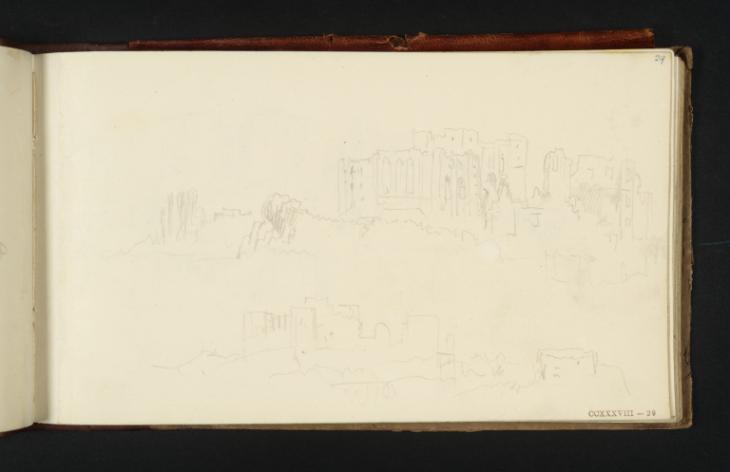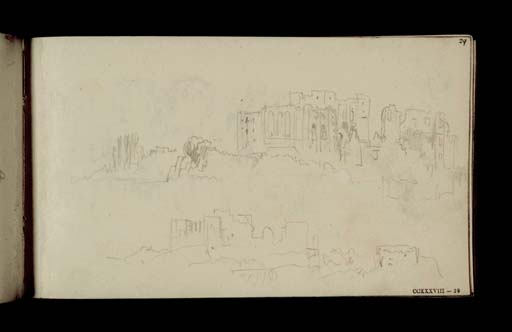J.M.W. Turner
>
1830-35 Annual tourist
>
Midlands 1830
>
Kenilworth Sketchbook
>
Artwork
Joseph Mallord William Turner Kenilworth Castle from the South-West 1830
Image 1 of 2
Joseph Mallord William Turner,
Kenilworth Castle from the South-West
1830
Joseph Mallord William Turner 1775–1851
Folio 29 Recto:
Kenilworth Castle from the South-West 1830
D22028
Turner Bequest CCXXXVIII 29
Turner Bequest CCXXXVIII 29
Pencil on white wove paper, 120 x 203 mm
Partial watermark ‘rnard | 20’
Inscribed by John Ruskin in blue ink ‘29’ top right
Stamped in black ‘CCXXXVIII – 29’ bottom right
Partial watermark ‘rnard | 20’
Inscribed by John Ruskin in blue ink ‘29’ top right
Stamped in black ‘CCXXXVIII – 29’ bottom right
Accepted by the nation as part of the Turner Bequest 1856
References
1909
A.J. Finberg, A Complete Inventory of the Drawings of the Turner Bequest, London 1909, vol.II, p.730, CCXXXVIII 29 (as ‘Do.’, i.e. ditto, Kenilworth Castle, as for folio 28 recto D22026).
1979
Eric Shanes, Turner’s Picturesque Views in England and Wales 1825–1838, London 1979, p.156.
The town of Kenilworth, Warwickshire, with the extensive castle of the same name on its west side, lies five miles north of Warwick (see under folio 38 verso; D22047) and about the same distance south of Coventry (see under folio 40 verso; D22051). The castle, now in the care of English Heritage, originated in 1120, with the outer walls added by King John in the early 1200s, when the low-lying surrounding fields were flooded as a vast moat. John of Gaunt built the Great Hall, and Elizabeth I’s favourite Robert Dudley, Earl of Leicester, developed the site as a Renaissance ‘prodigy house’ for the Queen’s visits (notably in 1575), adding the turreted gatehouse and Leicester’s Building. Dudley’s father, the Duke of Northumberland, had made comparable changes at Dudley Castle; see under folio 23 recto (D22016). Kenilworth’s fortifications were dismantled in 1650 after the Civil War, but by the time of Turner’s visit the imposing ruin was well known for its role in Sir Walter Scott’s 1821 novel Kenilworth, centred on Elizabeth and Leicester (see below).1 For Ashby-de-la-Zouch Castle, another Scott setting, see under folio 21 verso (D22012).
In the upper drawing here, the castle is seen from the south-west, with the Strong Tower and Saintlowe Tower flanking the Great Hall at the centre and the Great Tower rising beyond. Gaunt’s Tower and Leicester’s Building, on the south-eastern corner of the complex, are to the right. Below is a rudimentary outline version showing a slightly wider view including Mortimer’s Tower on the curtain wall.
Turner’s subsequent watercolour of about 1830 (Fine Arts Museums of San Francisco),2 an evening scene with the full moon rising, was engraved as Kenilworth Castle, Warwickshire in 1832 for his Picturesque Views in England and Wales (see the introduction to the 1830 Midlands tour for a concordance of relevant subjects). Most of the sketches between folios 27 recto (D22024) and 37 verso (D22045) show Kenilworth. Eric Shanes has described the watercolour as a ‘synthesis’ of sketches between folios 28 verso opposite (D22027) and 37 verso;3 the present view is the closest in terms of the profile and juxtaposition of the various elements of the castle.
An undated watercolour of An Arch in Kenilworth Castle was acquired by the London dealers Spink in 1980;4 it apparently dates from c.1789–90,5 but it is unclear whether Turner had visited the site by then or relied on an existing image. In Andrew Wilton’s entry in the present catalogue for Tate D00361 (Turner Bequest XXII H), a pencil drawing made at Kenilworth in 1794, he also identifies a sketch in the Lloyd Bequest at the British Museum, London (1958–7–12–397), traditionally known as ‘Old Ruins (at Evesham?)’ as another Kenilworth view made on the same occasion. Kenilworth: Moonlight is an untraced watercolour of about 1835, possibly meant for use in Fisher’s Illustrations to the Waverley Novels of Scott,6 while an undated drawing attributed to Turner is in the Mead Art Museum at Amherst College, Massachusetts.
Matthew Imms
August 2013
See [Anna Keay], ‘History of Kenilworth Castle’, English Heritage, accessed 20 June 2013, http://www.english-heritage.org.uk/daysout/properties/kenilworth-castle/history-and-research/history/ ; for Turner and Scott see Gerald Finley, ‘Scott, Sir Walter (1771–1832)’ in Evelyn Joll, Martin Butlin and Luke Herrmann (eds.), The Oxford Companion to J.M.W. Turner, Oxford 2001, p.135.
How to cite
Matthew Imms, ‘Kenilworth Castle from the South-West 1830 by Joseph Mallord William Turner’, catalogue entry, August 2013, in David Blayney Brown (ed.), J.M.W. Turner: Sketchbooks, Drawings and Watercolours, Tate Research Publication, September 2014, https://www


